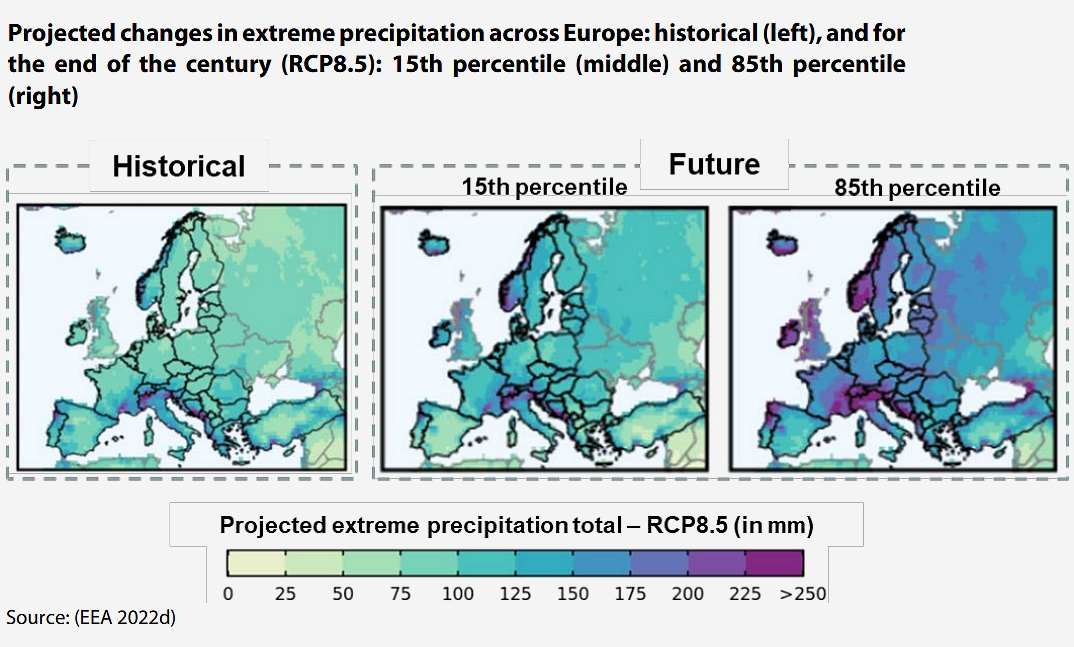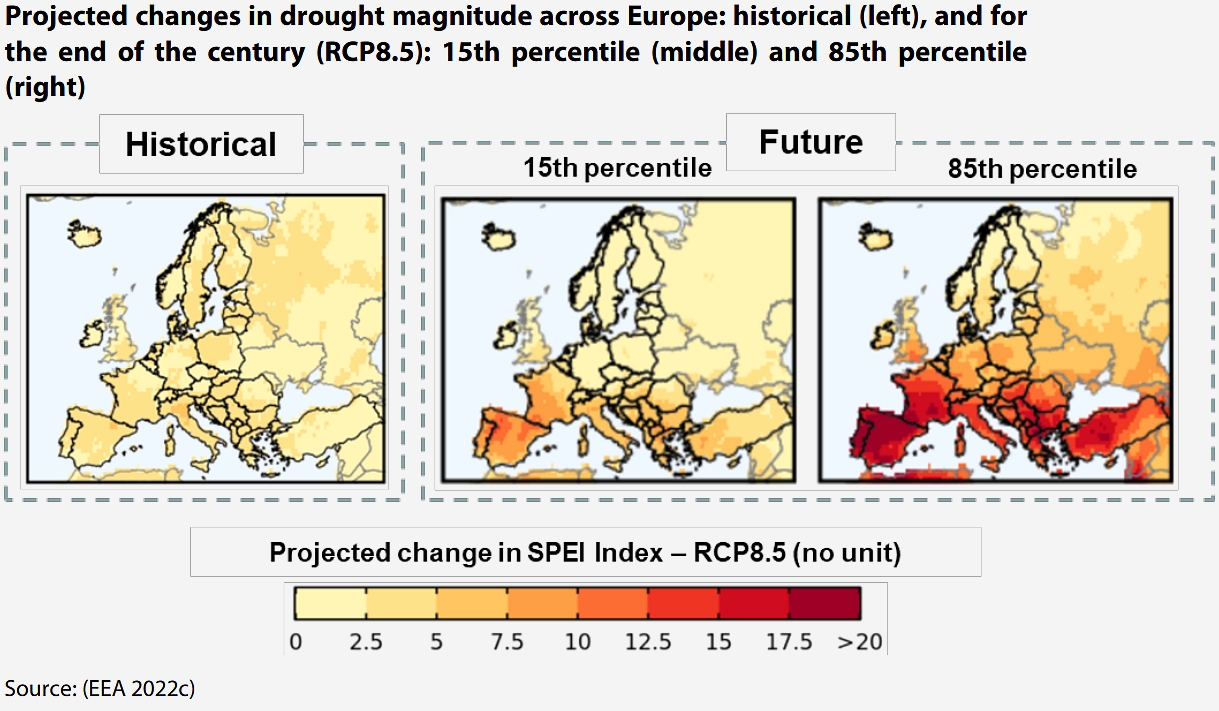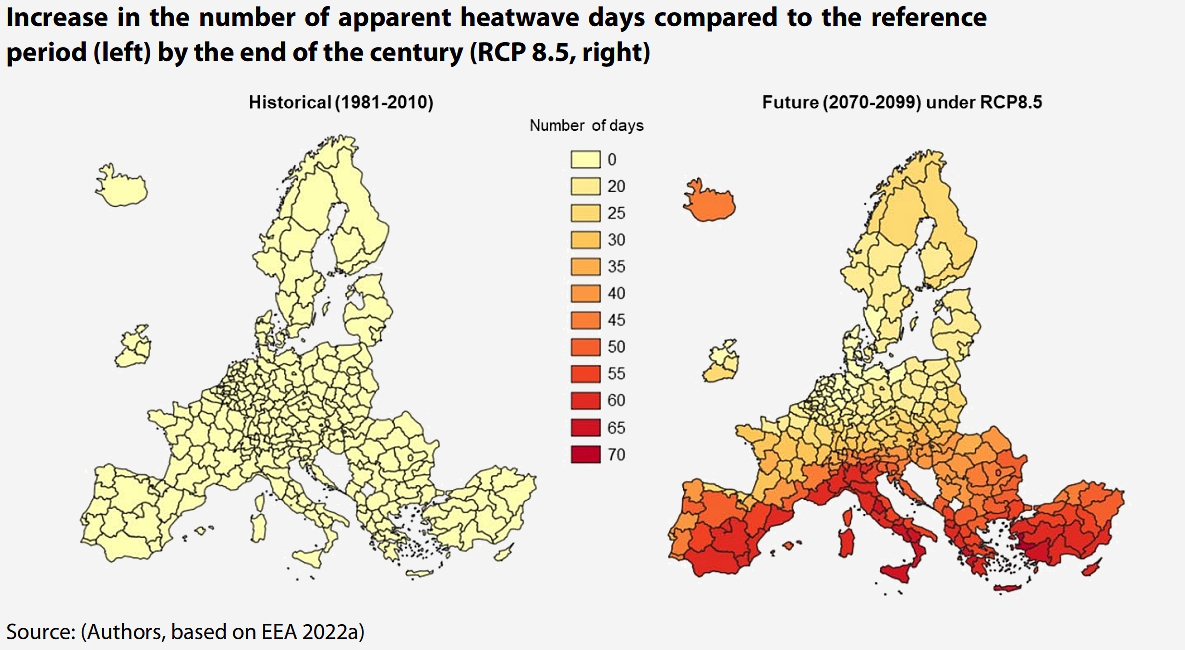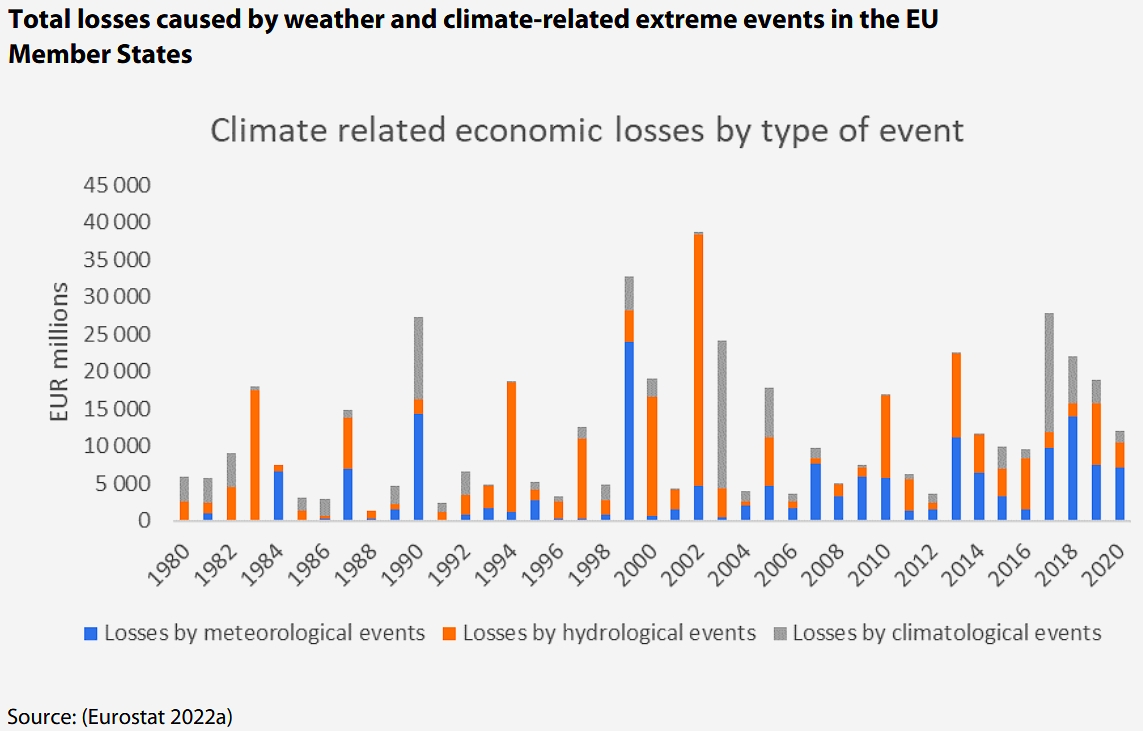Historical and projected trends in the occurrence and the severity of extreme events converge towards similar pictures: an increase in extremely hot summer temperatures over all of Europe, progressively drier conditions in the South of Europe, and an increase in heavy rainfall episodes in Northern and Central Europe.
In April 2023, the AGRI Committee submitted to the European Parliament a report entitled "The impact of extreme climate events on agriculture production in the EU".
This study examines how the experienced and projected increase of extreme weather and climate events throughout the EU territory impacts the agricultural production in the EU, hence triggering adaptive solutions by the sector and possible policy responses to make agriculture more climate resilient. It provides an overview of the impacts of extreme weather events that can be associated with climate change and available solutions for the agricultural sector. It also examines to which extent the actual policy instruments pro-actively support the adaptation of the agricultural sector, both at EU and national levels and provides best practice examples drawn from case studies on how to further contain the adverse effects of climate change for agriculture.
From this lengthy document, Tomato News had a special focus on the key findings of the second part of the study, dedicated to the “Existing scientific evidence on past and upcoming physical and socio-economic impacts through extreme climate events on EU’s agricultural sector”:
 Climate extremes are increasing across Europe with pronounced regional differences, following established trends for the recent past.
Climate extremes are increasing across Europe with pronounced regional differences, following established trends for the recent past. Northern Europe and mountainous regions will likely see more heavy precipitation extremes, while Southern Europe will be faced with severe drought and temperature extremes. Central Europe will endure both heat extremes and an increase in heavy precipitation.
Northern Europe and mountainous regions will likely see more heavy precipitation extremes, while Southern Europe will be faced with severe drought and temperature extremes. Central Europe will endure both heat extremes and an increase in heavy precipitation. Drought and heat have caused by far the largest share of negative economic impacts to European agriculture and this is expected to continue into the future.
Drought and heat have caused by far the largest share of negative economic impacts to European agriculture and this is expected to continue into the future. Productions vulnerable to climate extremes include maize (heat), tubers (flooding), soybean (high yield variability). Most crops will suffer heavy yield damage in case of drought, so the extent of good soil management, crop selection and water management, in particular natural and artificial water retention and irrigation practices, is a major factor in future vulnerability. Grassland is susceptible to drought, causing cascading impacts on the livestock sector.
Productions vulnerable to climate extremes include maize (heat), tubers (flooding), soybean (high yield variability). Most crops will suffer heavy yield damage in case of drought, so the extent of good soil management, crop selection and water management, in particular natural and artificial water retention and irrigation practices, is a major factor in future vulnerability. Grassland is susceptible to drought, causing cascading impacts on the livestock sector.
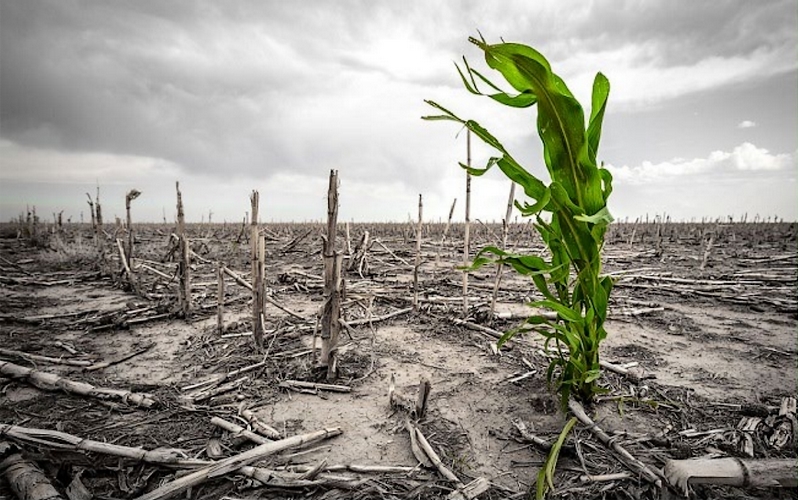 Phenomena such as heatwaves, cold spells, heavy rains, storm surges, flooding, landslides, droughts, wildfires and intense storms (wind, hail) can be termed extreme events. When such phenomena occur simultaneously, they are referred to as compound events. Climate change may influence the frequency and severity of extreme events, this attribution being particularly clear-cut for heatwaves.
Phenomena such as heatwaves, cold spells, heavy rains, storm surges, flooding, landslides, droughts, wildfires and intense storms (wind, hail) can be termed extreme events. When such phenomena occur simultaneously, they are referred to as compound events. Climate change may influence the frequency and severity of extreme events, this attribution being particularly clear-cut for heatwaves. Historical and projected trends in the occurrence and the severity of extreme events converge towards similar pictures: an increase in extremely hot summer temperatures over all of Europe, progressively drier conditions in the South of Europe, and an increase in heavy rainfall episodes in Northern and Central Europe. The magnitude of these increases is concerning. The number of climatological heatwave days will see at least a fivefold increase by the end of the century in the coolest climates, and up to thirty times more in warmer climates. Drought severity in Southern Europe could triple by the end of the century.
Losses specific to the agriculture sector account for more than 60% of drought-linked losses, or around €5 billion annually (based on Naumann et al, 2021). This is projected to increase in the future. Extreme events also have cascading consequences on ecological functions and on farming economics.
Vulnerable sub-sectors include non-irrigated cereals, and specifically maize; fruit trees and perennials; tubers grown in regions with heavy precipitation extremes; and livestock for its dependence on green fodder.
Historical and observed trends across the EU
Extremely hot temperatures have been attained with increasing regularity throughout Europe since 1950. The continent is indeed becoming a heatwave hotspot (Rousi et al. 2022): with the exception of 2016, summer heatwaves have occurred annually since 2015.
The frequency of heavy precipitation extremes has increased in Northern Europe (NEU) and Western and Central Europe (WCE). In the Mediterranean basin, heavy precipitation has not appeared to change, while low precipitation extremes have become more common (Christidis et Stott 2022). Indeed, agricultural droughts have increased overall in WCE and SEU but decreased slightly in NEU. Multiyear droughts such as the one that occurred during 2014-2018 in Central Europe are particularly detrimental to ecosystems and agriculture (Moravec et al. 2021). In parallel, a substantial increase in the frequency and spatial extent of flash droughts during the crop growing season has been observed in Central and Southern Europe (Shah et al. 2022).
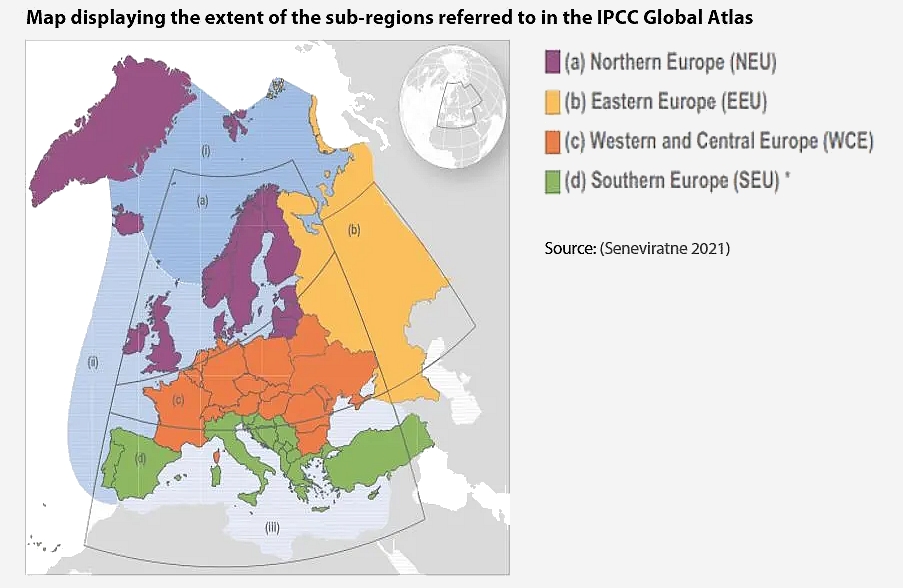
Flash drought is a type of extreme event characterized by rapid intensification of drought/dryness conditions, unlike conventional droughts. Flash droughts are mostly short-duration, intense drought events causing multifaceted impacts on water resources, agriculture, and ecosystem. Unlike conventional droughts (i.e., slow- developing droughts), which are mainly attributed to the decline in precipitation, the onset of flash droughts occurs when low precipitation is accompanied by abnormally high temperature, high winds and/or change in atmospheric radiation
Trends are computed over thirty-year averages, and a single occurrence should not be mistaken for evidence of a trend. Nonetheless, many recent events fit with the above stated trends in precipitation and temperatures and exemplify how future conditions may grow harsher for agriculture. For instance, the 2022 growing season again saw a severe agricultural drought, combined with high temperatures.
Heatwaves were recorded in WCE in 2015, 2017, 2019, 2020, 2021, and 2022. Extreme rainfall and floods on a large scale occur more sporadically, with major events in 2010, 2016, and again in 2021.
Projected data is presented through two maps representing the low end (15th percentile) and high end (85th percentile) of the possible outcomes. RCP 8.5 is typically used for two reasons. First, it clearly shows the direction of climate trends. Second, it is most consistent with cumulative CO2 emissions (Schwalm, Glendon et Duffy 2020).
Extreme precipitation totals (cumulative precipitation received on days where precipitation exceeds the 99th percentile, in millimeters) is a useful indicator as it accounts for both the frequency and magnitude of extreme precipitation events. These are expected to increase broadly across Europe, prolonging trends in the distribution of current extremes. Totals could surpass 250mm in much of the Alps, in Norway and the North of Spain. Where a broad swath of Europe previously saw no more than 100mm of extreme precipitation, the high range of projections show that 150mm will become the norm.
The drought magnitude index shows a slight decrease in Northern Europe in future trends, but a marked increase across much of central Europe and a tripling in magnitude across the whole of Southern Europe. Such an increase in the intensity of meteorological droughts could have catastrophic repercussions on agricultural systems in large parts of Europe.
An increase in the number of heatwave days is projected over all of Europe, with significant variation depending on latitude. The increase is most pronounced in the Mediterranean border regions, the North of Italy, and central Spain, where the number of heatwave days could increase thirtyfold compared to the 1971 – 2000 reference period.
Major trends for the European sub-regions, as presented in the IPCC’s Regional Atlas, are the following:
 Extreme temperatures and heat indices are projected to increase across all of Europe. For instance, a heatwave that occurred every 10 years in the pre-industrial period will now occur every 3.5 years, and in the future will occur every 1.8 years. A heatwave that occurred every 50 years in the pre-industrial period will now take place every 10 years, and every 3 to 4 years in future. The peak temperature reached during these heatwave events will also increase by 2.6°C.
Extreme temperatures and heat indices are projected to increase across all of Europe. For instance, a heatwave that occurred every 10 years in the pre-industrial period will now occur every 3.5 years, and in the future will occur every 1.8 years. A heatwave that occurred every 50 years in the pre-industrial period will now take place every 10 years, and every 3 to 4 years in future. The peak temperature reached during these heatwave events will also increase by 2.6°C. Agricultural droughts are projected to increase in WCE and SEU but decrease in NEU. However, flash droughts are projected to increase across Europe, which is projected to become a flash drought hotspot.
Agricultural droughts are projected to increase in WCE and SEU but decrease in NEU. However, flash droughts are projected to increase across Europe, which is projected to become a flash drought hotspot. Compound events of hot and dry will be particularly prevalent in the SEU region. Warming is particularly strong for winter temperatures in NEU and for summer temperatures in SEU region. Very hot days are projected to increase in the central-southern areas of the Iberian Peninsula.
Compound events of hot and dry will be particularly prevalent in the SEU region. Warming is particularly strong for winter temperatures in NEU and for summer temperatures in SEU region. Very hot days are projected to increase in the central-southern areas of the Iberian Peninsula. Frost and cold spell events will generally decrease across Europe.
Frost and cold spell events will generally decrease across Europe. Heavy precipitation will generally increase across Europe, though confidence in projections remain weak for MED region
Heavy precipitation will generally increase across Europe, though confidence in projections remain weak for MED region
Impacts of extreme climate events on agriculture production in Europe
Agriculture is particularly sensitive to variation in weather, especially temperature and rainfall patterns, and is therefore vulnerable to extreme climate events. They can harm agricultural production by causing physical damage to harvest or livestock. The impact of past extreme events is usually measured in yield losses translated to economics losses (see section 2.2.2), using datasets such as crop yield from FAO and/or disaster monitoring data. Assessing the impact of future extreme events is complex and relies on various modelling approaches: chiefly empirical (e.g., statistical regression), process-based (crop yield estimates) and integrated (cost estimates) modelling approaches. It is important to note that in most studies projecting future yield, the effects of extreme weather conditions are oversimplified. For example, extreme high temperatures and/or precipitation events occurring at crop anthesis can considerably reduce grain/fruit formation and impede flowering. The accuracy of impact projections also depends on the accuracy of projected climate data and how well they capture future extremes. This means that many studies may actually underestimate the future impacts of climate change on crop productivity, especially in Europe where the impacts of extreme events are expected to be quite high (Van Oort et al. 2012).
Economic losses are the primary indicator for comparing the impacts of extreme events. Extreme weather events have caused damages reaching nearly €487 billion to EU economies since 1980 (EEA 2022a). This plainly show both the high interannual variability of extreme events and their impacts, and a steady increase in the thirty-year rolling average since 2008.
Regarding the agriculture sector specifically, (Naumann et al. 2021) estimated that agriculture losses account for more than 50% of total drought losses in Europe, with the highest sector share in the Mediterranean region (60%) and the lowest in the boreal region (39%). Importantly, 3% of extreme events are responsible for 60% of the economic losses.
A global-level assessment of the economic impact of drought on staple crop production (Kim, Iizumi, et Nishimori 2019) finds that the cumulative production losses between 1983 and 2009 related to droughts surpass 150 billion worldwide, with 75% of the world’s arable area affected at some point. France (US$6 billion), Italy (US$3 billion), Romania (US$2.5 billion), Spain (US$2 billion), Hungary (US$1 billion), and Poland (US$1 billion) are among the top-25 countries enduring related economic losses. Annual revenue losses are estimated at €23 million in Germany owing to drought (Schmitt et al. 2022).
In terms of future economic damage, analyses performed using Integrated Assessment Modelling show staggering increases. In one study, historical damage from heatwaves reached 0.3 – 0.5% of European GDP, projected to increase fivefold by 2060 (García-León et al. 2021). The economic cost of drought for Europe’s agriculture sector stood at around €4.8 billion annually in 2015 and might reach €28.6 billion by 2100 under pessimistic scenarios (Naumann et al. 2021).
Some complementary data
Reference: Devot, A., Royer, L., Arvis B., Deryng, D., Caron Giauffret, E., Giraud, L., Ayral, V., and Rouillard, J. 2023, Research for AGRI Committee – The impact of extreme climate events on agriculture production in the EU, European Parliament, Policy Department for Structural and Cohesion Policies, Brussels
Source: europarl.europa.eu





